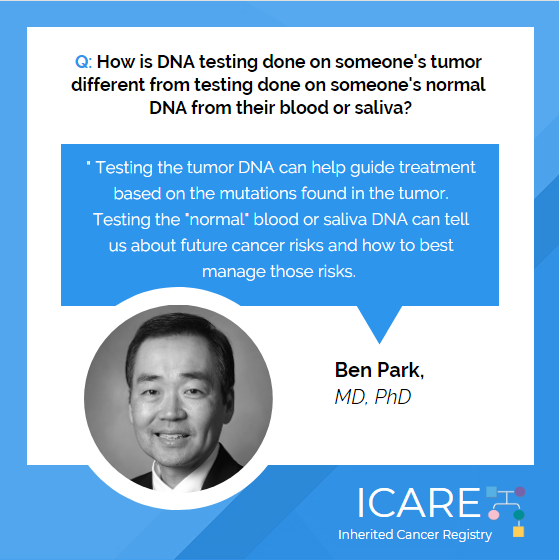 Through each newsletter, we give our participants an opportunity to have their questions answered by experts. If you have a question you would like addressed, please email the study team at ICARE@InheritedCancer.net for consideration in future newsletters. The following question was addressed by Ben Ho Park, MD, PhD, who is the Donna S. Hall Chair in Breast Cancer, Co-Leader of the Breast Cancer Research Program, Associate Director for Translational Research, and Director of Precision Oncology at Vanderbilt-Ingram Cancer Center. Dr. Park is also a Professor of Medicine and Associate Director for Basic and Translational Research in the Department of Medicine’s Division of Hematology and Oncology.
Through each newsletter, we give our participants an opportunity to have their questions answered by experts. If you have a question you would like addressed, please email the study team at ICARE@InheritedCancer.net for consideration in future newsletters. The following question was addressed by Ben Ho Park, MD, PhD, who is the Donna S. Hall Chair in Breast Cancer, Co-Leader of the Breast Cancer Research Program, Associate Director for Translational Research, and Director of Precision Oncology at Vanderbilt-Ingram Cancer Center. Dr. Park is also a Professor of Medicine and Associate Director for Basic and Translational Research in the Department of Medicine’s Division of Hematology and Oncology.
Q. How is DNA testing done on someone’s tumor different from testing done on someone’s normal DNA from their blood or saliva sample?
A. When we extract DNA from a biopsy or surgical sample of a tumor, usually it is a mixture of both normal cells and tumor cells. This is because normal cells such as blood vessels and blood cells are found within the tumor itself. However, all tumors arise because of changes in our normal DNA. Sometimes we have inherited DNA changes like BRCA1/2, but all tumors, including BRCA1/2-associated tumors, will have additional DNA changes that are present only in the tumor cells. Usually it takes 3 to 8 DNA changes to make a normal cell cancerous. Therefore, when we analyze these changes using a biopsy or surgical sample, we cannot tell whether the changes are in the tumor cells only, or present in both tumor and normal cells, since it is a mixture of these cells. DNA that has changes in normal cells, like BRCA1/2 mutations, are called “germline”. These are DNA changes that a person was born with and present in almost every cell of their body. These DNA changes can be passed to their children.
The reason it is important to test tumor DNA is because it can help guide treatment based on mutations that are found in the tumor cells. However, we can now identify whether a DNA change is in the germline vs. the tumor only by also testing normal DNA separately, usually through a blood or saliva sample and comparing germline vs. tumor DNA changes. Testing someone’s normal DNA can now help guide treatment since we have newer therapies against germline DNA changes. It can also tell us about future cancer risks and how to best manage those risks, as well as tell us about potential cancer risks for someone’s blood relatives. It is also important to remember that when testing is done on tumor and/or germline DNA, it may also uncover potential germline mutations found in the normal cells that are unexpected and not related to someone’s cancer. However, this information is still potentially important to help guide future cancer risks and management and to inform potential inherited cancer risks for family members.
